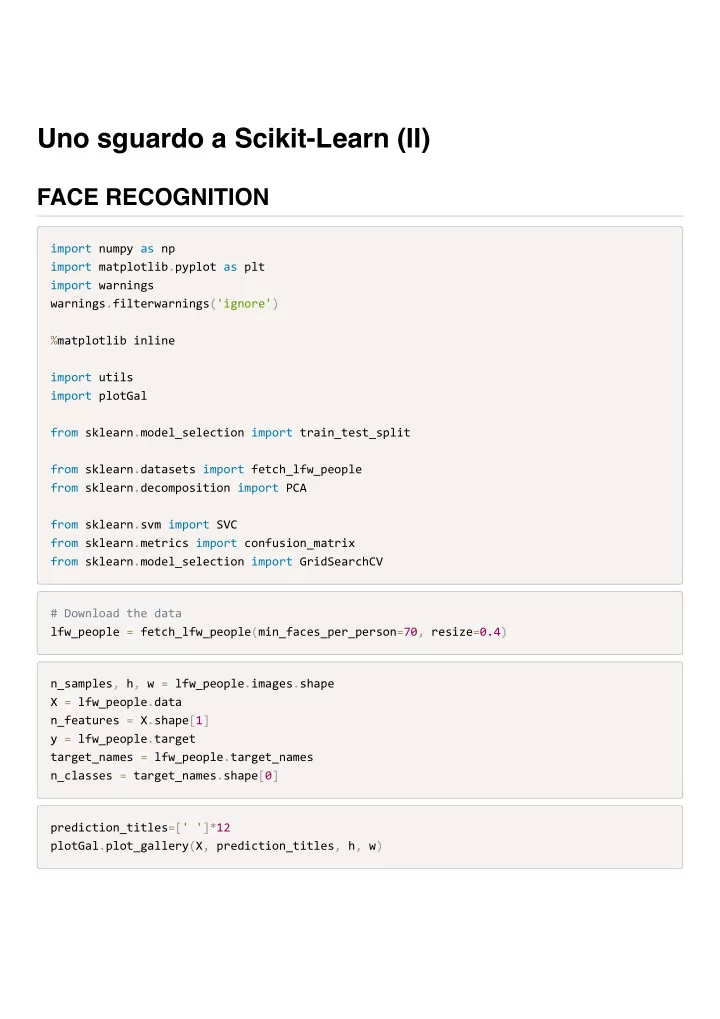

Uno sguardo a Scikit-Learn (II) FACE RECOGNITION import numpy as np import matplotlib.pyplot as plt import warnings warnings.filterwarnings('ignore') %matplotlib inline import utils import plotGal from sklearn.model_selection import train_test_split from sklearn.datasets import fetch_lfw_people from sklearn.decomposition import PCA from sklearn.svm import SVC from sklearn.metrics import confusion_matrix from sklearn.model_selection import GridSearchCV # Download the data lfw_people = fetch_lfw_people(min_faces_per_person=70, resize=0.4) n_samples, h, w = lfw_people.images.shape X = lfw_people.data n_features = X.shape[1] y = lfw_people.target target_names = lfw_people.target_names n_classes = target_names.shape[0] prediction_titles=[' ']*12 plotGal.plot_gallery(X, prediction_titles, h, w)
print("Total dataset size:") print("n_samples: %d" % n_samples) print("n_features: %d" % n_features) print("n_classes: %d" % n_classes) Total dataset size: n_samples: 1288 n_features: 1850 n_classes: 7 # split into a training and testing set X_train, X_test, y_train, y_test = train_test_split( X, y, test_size=0.25, random_state=42)
# Compute PCA (dimensionality reduction) n_components = 15 print("Extracting the top %d eigenfaces from %d faces" % (n_components, X_train.shape[0])) pca =PCA(svd_solver='randomized' ,n_components=n_components, whiten=True).fit(X_train) eigenfaces = pca.components_.reshape((n_components, h, w)) X_train_pca = pca.transform(X_train) X_test_pca = pca.transform(X_test) Extracting the top 15 eigenfaces from 966 faces eigenface_titles = ["eigenface %d" % i for i in range(eigenfaces.shape[0])] plotGal.plot_gallery(eigenfaces, eigenface_titles, h, w)
# CLASSIFICARE clf=SVC(kernel='rbf', class_weight='balanced', C=1e5, gamma= 0.01) clf = clf.fit(X_train_pca, y_train) y_pred = clf.predict(X_test_pca) print ('Confusion Matrix:') print(confusion_matrix(y_test, y_pred, labels=range(n_classes))) accuracy=( (y_pred==y_test).mean()*100 ) print ('\nAccuracy:',accuracy) Confusion Matrix: [[ 5 5 1 2 0 0 0] [ 6 41 3 9 1 0 0] [ 3 2 14 8 0 0 0] [ 5 14 20 93 6 3 5] [ 0 0 1 7 11 1 5] [ 0 2 0 2 2 6 3] [ 1 3 2 11 4 1 14]] Accuracy: 57.14285714285714 Scelta (iper)parametri param_grid = {'C': [1e2, 1e3, 5e3, 1e4, 5e4], 'gamma': [0.0001, 0.0005, 0.001, 0.005, 0.01, 0.1], } clf = GridSearchCV(SVC(kernel='rbf', class_weight='balanced'), param_grid) clf = clf.fit(X_train_pca, y_train) print("Best estimator found by grid search:") print("\n\n",clf.best_estimator_)
Best estimator found by grid search: SVC(C=100.0, cache_size=200, class_weight='balanced', coef0=0.0, decision_function_shape='ovr', degree=3, gamma=0.01, kernel='rbf', max_iter=-1, probability=False, random_state=None, shrinking=True, tol=0.001, verbose=False) CLASSIFICA y_pred = clf.predict(X_test_pca) print ('Confusion Matrix:') print(confusion_matrix(y_test, y_pred, labels=range(n_classes))) accuracy=( (y_pred==y_test).mean()*100 ) print ('\nAccuracy:',accuracy) Confusion Matrix: [[ 5 6 1 1 0 0 0] [ 7 46 2 3 2 0 0] [ 3 2 16 6 0 0 0] [ 5 10 9 101 7 4 10] [ 0 0 1 5 11 2 6] [ 0 2 0 1 2 6 4] [ 1 3 2 4 4 2 20]] Accuracy: 63.66459627329193 GALLERY prediction_titles = [plotGal.title(y_pred, y_test, target_names, i) for i in range(y_pred.shape[0])] plotGal.plot_gallery(X_test, prediction_titles, h, w)
Recommend
More recommend